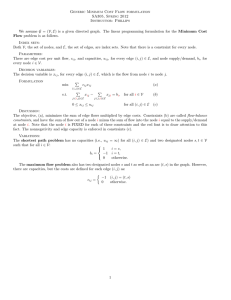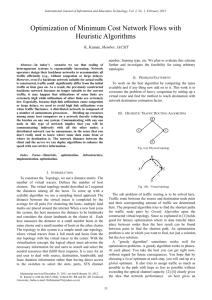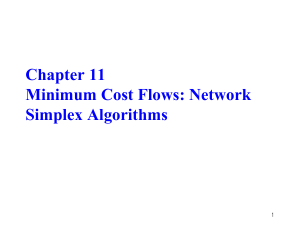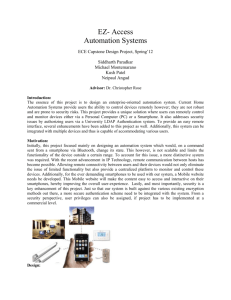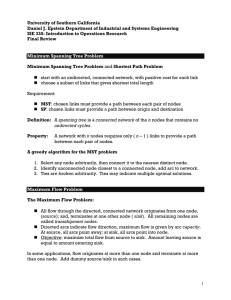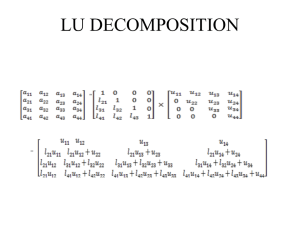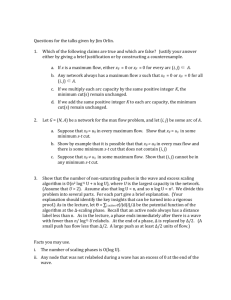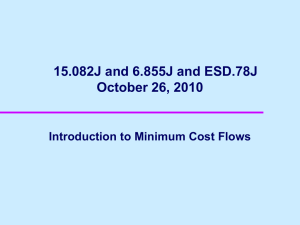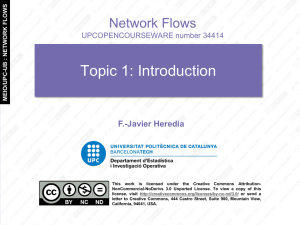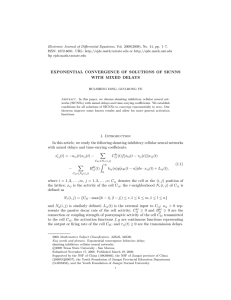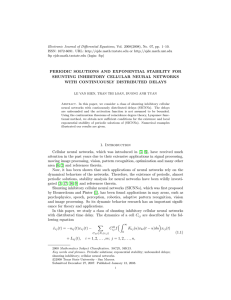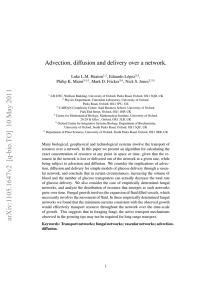Optimization of Network Distance Estimation with Heuristic
advertisement
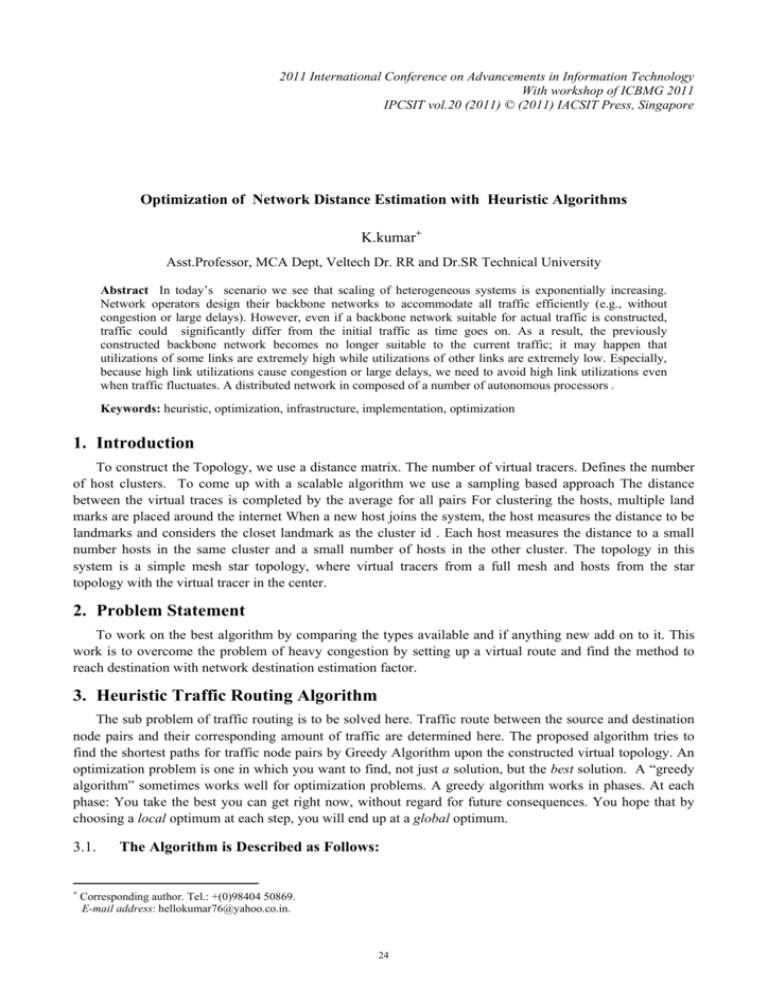
2011 International Conference on Advancements in Information Technology
With workshop of ICBMG 2011
IPCSIT vol.20 (2011) © (2011) IACSIT Press, Singapore
Optimization of Network Distance Estimation with Heuristic Algorithms
K.kumar+
Asst.Professor, MCA Dept, Veltech Dr. RR and Dr.SR Technical University
Abstract In today’s scenario we see that scaling of heterogeneous systems is exponentially increasing.
Network operators design their backbone networks to accommodate all traffic efficiently (e.g., without
congestion or large delays). However, even if a backbone network suitable for actual traffic is constructed,
traffic could significantly differ from the initial traffic as time goes on. As a result, the previously
constructed backbone network becomes no longer suitable to the current traffic; it may happen that
utilizations of some links are extremely high while utilizations of other links are extremely low. Especially,
because high link utilizations cause congestion or large delays, we need to avoid high link utilizations even
when traffic fluctuates. A distributed network in composed of a number of autonomous processors .
Keywords: heuristic, optimization, infrastructure, implementation, optimization
1. Introduction
To construct the Topology, we use a distance matrix. The number of virtual tracers. Defines the number
of host clusters. To come up with a scalable algorithm we use a sampling based approach The distance
between the virtual traces is completed by the average for all pairs For clustering the hosts, multiple land
marks are placed around the internet When a new host joins the system, the host measures the distance to be
landmarks and considers the closet landmark as the cluster id . Each host measures the distance to a small
number hosts in the same cluster and a small number of hosts in the other cluster. The topology in this
system is a simple mesh star topology, where virtual tracers from a full mesh and hosts from the star
topology with the virtual tracer in the center.
2. Problem Statement
To work on the best algorithm by comparing the types available and if anything new add on to it. This
work is to overcome the problem of heavy congestion by setting up a virtual route and find the method to
reach destination with network destination estimation factor.
3. Heuristic Traffic Routing Algorithm
The sub problem of traffic routing is to be solved here. Traffic route between the source and destination
node pairs and their corresponding amount of traffic are determined here. The proposed algorithm tries to
find the shortest paths for traffic node pairs by Greedy Algorithm upon the constructed virtual topology. An
optimization problem is one in which you want to find, not just a solution, but the best solution. A “greedy
algorithm” sometimes works well for optimization problems. A greedy algorithm works in phases. At each
phase: You take the best you can get right now, without regard for future consequences. You hope that by
choosing a local optimum at each step, you will end up at a global optimum.
3.1.
+
The Algorithm is Described as Follows:
Corresponding author. Tel.: +(0)98404 50869.
E-mail address: hellokumar76@yahoo.co.in.
24
Step 1: Sort all traffic node pairs by their amount of traffic in descending order. Initialize the allowed
amount of traffic of every lightpath as C , which is the maximal capacity of the optical channel. Step 2: If
there are no traffic node pairs that have not been routed, the algorithm stops; otherwise, choose the node pair
with the largest amount of traffic, and then calculate the shortest path Psd from s to d . Step 3: Calculate the
MAT (Maximum Allotable Traffic) of Psd , and then add traffic λ = min(C − MAT , λsd ) to all optical channels that
Psd covers. ( MAT = min(λij ) , λij is the allotable capacity of Cij , and Cij is the optical channel that Psd covers.)
Step 4: if λ sd − λ > 0 , calculate the next shortest path Psd from s to d , and then go to step 3; otherwise, mark
( s , d ) routed, choose the next node pair ( s , d ) , and then go to step 2.
4. Implementation
4.1.
The First Methods to Get Acquainted with:
The two most important methods for developers to get familiar with are as follows:
•
in sr_router.c
void sr_handlepacket(struct sr_instance* sr,
uint8_t * packet/* lent */,
unsigned int len,
char* interface/* lent */)
This method is called by the router each time a packet is received. The "packet" argument points to the
packet buffer which contains the full packet including the ethernet header. The name of the receiving
interface is passed into the method as well. One way to access the fields in this packet is to "typecast" the
pointer to the appropriate structure: e_hdr = (struct sr_ethernet_hdr*) packet.The order of the bits in packets
on the network may be different from this order on the host. You need to use functions like: htons -- host to
network short and ntohs -- network to host short.
5. Optimization: Minimum Cost Network Flows
The above methodology when implemented was found not to give the best optimized Solution. This
model represents the broadest class of problem that can be solved much faster than linear programming
while still retaining such nice properties as integrality of solution and appeal of concept. Like the maximum
flow problem, it considers flows in networks with capacities. Like the shortest path problem, it considers a
cost for flow through an arc. Like the transportation problem, it allows multiple sources and destinations. In
fact, all of these problems can be seen as special cases of the minimum cost flow problem. Consider a
directed network with n nodes. The decision variables are xij, the flow through arc (i,j). The given
information includes:
Cij: cost per unit of flow from i to j (may be negative),
uij: capacity (or upper bound) on flow from i to j,
bi: net flow generated at i.
This last value has a sign convention:
bi >0 if i is a supply node, bi <0if i is a demand node,
bi = 0if i is a transshipment node.
The objective is to minimize the total cost of sending the supply through the network to satisfy the
demand. Note that for this model, it is not necessary that every arc exists. We will use the convention that
summations are only taken over arcs that exist. The linear programming formulation for this problem is:
Minimize i j cij xij
Subject to
j
xij j x ji bi for all nodes i,
0 xij uij for all arcs i, j
25
Again, we will assume that the network is balanced, so
b 0 , since dummies can be added as
i i
needed. We also still have a nice integrality property. If all the bi and uij are integral, then the resulting
solution to the linear program is also integral.
Can do: Lower bounds on arcs. If a variable xij has a lower bound of lij , upper bound of uij , and cost
of cij change the problem as follows:
Replace the upper bound with uij lij ,
Replace the supply at i with bi lij ,
Replace the supply at j with bi lij ,
Now you have a minimum cost flow problem. Add cij lij to the objective after solving and lij to the flow
on arc (i,j) to obtain a solution of the original problem.
6. Conclusion
The above algorithms will help in minimizing average weighted number of hops. The congestion in
networks will be reduced. The algorithms implemented will minimize the message delay. By implementing
the virtual topology concept, end users/applications can self-provision and configure the networks by
themselves and the entire technical configuration will be completely transparent for them.
7. Future Work
To achieve optimality, decision-making processes in a pervasive grid must take into account several
aspects. The infrastructure topology and condition such as communication, computation and storage
capabilities should be studied. The characteristics of the task for network distance estimation will study the
task: file, service. The objectives to be achieved: End-user response delay, load balancing, limitation of
financial costs.
8. References
[1] S. Banerjee, Z. Xu, S.-J. Lee, and C. Tang, “Service adaptive multicast for media distribution networks,” in
Proceedings of the IEEE WIAPP 2003, San Jose, CA, June 2003, pp. 50–60.
[2] Asaf Levin, and Yuval Shavitt. ``Approximation and Heuristic Algorithms for Minimum-Delay Application
Layer Multicast Trees'' IEEE/ACM Transactions on Networking, 15(2):473--484, April 2007.
[3] R. Cox, F. Dabek, F. Kaashoek, J. Li, and R. Morris, “Practical, distributed network coordinates,” in Proceedings
of the ACM HotNets-II, 2003.
[4] P. Francis, S. Jamin, C. Jin, Y. Jin, D. Raz, Y. Shavitt, and L. Zhang, “IDMaps: A global internet host distance
estimation service,” IEEE/ACM Trans. Networking, vol. 9, no. 5, pp. 525–540, October 2001.
[5] K. P. Gummadi, S. Saroiu, and S. D. Gribble, “King: Estimating latency between arbitrary internet end hosts,” in
Proceedings of the ACM IMW’2002.
[6] S. Srinivasan and E. Zegura, “M-coop: A scalable infrastructure for network measurement,” in Proceedings of the
IEEE WIAPP 2003.
[7] B. Zhang, S. Jamin, and L. Zhang, “Host multicast: A framework for delivering multicast to end users,” in
Proceedings of the IEEE INFOCOM 2002, New York, NY, June 2002.
26
[8] T. S. E. Ng and H. Zhang. Predicting internet network distance with coordinates-based approaches. In Int. Conf. on
Computer Communications (INFOCOM'01), pages 170{179, 2001.
[9] M. Potamias, F. Bonchi, C. Castillo, and A. Gionis. Fast shortest path distance estimation in large networks. In
Proc. 2009 Int. Conf. Information and Knowledge Management (CIKM'09), pages 867{876, 2009.
[10] R. Govindan and H. Tangmunarunkit, “Heuristics for Internet Map Discovery,” in
INFOCOM ’00, Tel Aviv, Israel, March 2000.
27
Proceedings of IEEE

